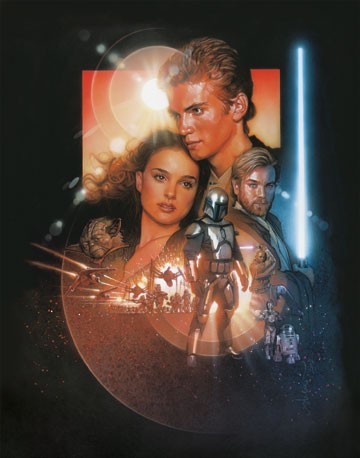
Lucas Strikes Back
In 1999, George Lucas returned to the director’s chair and his Star Wars franchise to released Episode I: The Phantom Menace, a box-office smash that withered under the derision of critics and the disappointment of fans. Given the tepid reaction to this first prequel, the big question looming over his follow-up feature, Attack of the Clones, has been “is it better than its predecessor?”
And the answer is a resounding “yes.” Though overly long, Attack of the Clones pulls through on the strength of a staggering final act to become, if not the best, certainly one of the more enjoyable entries in the Star Wars canon.
Attack of the Clones is the first Star Wars movie to feature a complicated plot. Whereas the other films have been traditional action flicks, following point A and point B to point C, Clones is more convoluted. Focusing mostly on the budding love between Jedi-in-training Anakin Skywalker (Hayden Christensen) and Senator Padme Amidala (Natalie Portman), the film weaves this tale together with a detective story in which Ewan McGregor’s Obi-Wan Kenobi tracks the deadly bounty hunter Jango Fett (played by New Zealander Temuera Morrison).
Unfortunately, Lucas lingers too long on the romantic story, which is forced and uneven. Saddled with the worst of the series’ laughingly bad dialogue, the romantic scenes all fall flat. Though Christensen tries to push some emotion into the affair, Lucas’ heavy-handed directing and clumsy editing strip the tale of any tension or resonance. Though we know these two are going to fall in love, we never see it happen. The fact that the audience is aware something is coming is no excuse to avoid the heavy lifting of showing us a developing relationship. Perhaps writing romance requires talents as a scribe that Lucas simply lacks.
More interesting is Obi-Wan’s series of adventures as he tracks the would-be assassin Jango to a watery world where reclusive aliens have been growing an army that is a surprise to the Jedi and a delight to Star Wars fans. McGregor, no longer playing second fiddle to Liam Neeson’s Qui-Gon Jinn, pulls this plot, and the movie, forward. Laying claim to the character as his own, while evoking Alec Guinesses’ performance from the original Wars flicks, McGregor shines. Whether sparring physically with Jango or verbally with Christopher Lee’s villainous Count Dooku, McGregor invests his performance with energy and charm.
Eventually the two main plots dovetail, rather clumsily, with a political subplot involving a Separatist movement led by Lee that is tearing the Galactic Republic in two. The result is a staggering final act that, through sheer energy and digital legerdemain, eclipses any sequence ever showcased in a Star Wars film. Mixed in with all this is the same mish-mash of Jedi prophecy and Sith intrigue that drove Phantom Menace’s pacing into the ground.
Sound like a lot to fill two and a half hours? It is. And the result of juggling all these storylines is a movie that is boring in parts, and moves far too quickly in others. Add to the pacing problems the fact that many characters lie about what they’re doing and have two (or more) totally different names, and you have a recipe for audience confusion.
If the Star Wars movies aren’t known for their well-scripted plots, they’re even less regarded for the quality of their acting. And sadly, this trend continues in Clones. Throughout the film, Portman is flat and bored, often painful to watch. Christensen tries harder than she, but its clear he’s getting no support from behind the camera, and his Anakin is a mixed bag, whiney in one scene, morose in the next, but never quite consistent. Lucas is not an actor’s director, he’s more interested in his computer-generated toys than the human players, resulting in performances that are painfully analog in a digital world.
The more seasoned actors are also adrift, but their experience gives their performances buoyancy. Ian McDiarmid, reprising his role of Chancellor Palpatine from Phantom Menace and Return of the Jedi, gives the strongest effort in the film, as he manipulates Anakin, Jar-Jar and even the mighty Jedi to do his bidding. Christopher Lee and Samuel L. Jackson also devour great swaths of scenery in their enjoyable roles.
But the most surprising performance comes from Lucas’ newest digital thespian: the computer-generated Yoda. Spry and mobile in ways that his previous puppet incarnation never was, the new Yoda is a joy to watch. Frank Oz still provides the voice, and the character still has the same wry smile and twinkling eyes, but in this film the CGI gives Yoda a chance to cut loose and show the world what a Jedi Master really is.
But while Yoda is the most successful component of Clones, he is also a symbol for everything that is wrong with the new Star Wars trilogy. Lucas’ obsession with all things digital continues to override his sense of storytelling and drama. Actors work best in real environments, but throughout making this film Lucas had his performers dutifully reciting lines against a sea of blue screens, and it shows. There is often a disconnect between the performances and their surroundings. This abstraction renders many scenes flat and cold, and continues to prevent the audience from establishing the kind of bond with these characters that we had with Han, Luke and Leia from the classic Star Wars flicks.
Lucas has taken digital one step further with Attack of the Clones, circumventing film altogether, and recording the movie directly onto high definition digital videotape. This made the film cheaper and faster to make, and easier to edit. And when viewed on a digital projection screen, the picture is flawless, crystal clear and almost too perfect. However, there are reports that on standard film presentations the image is somewhat blurry. Digital “filming” is the future of movies, and as digital presentation cinemas become more common it will eclipse standard 35mm film in both clarity and financial savings. Lucas hopes to lead the way to this digital future with Clones and Episode III. But the tradeoffs when transferring the image back to standard film mean that if you want to see this movie the way it was intended, you need to go to a digital screening, like those at the Cinemark Legacy in Plano.
The Star Wars saga has always been a love letter from Lucas to the sci-fi serials he watched as a kid. While those hammy yarns were strung together on budgets in the hundreds of dollars, Lucas has spent hundreds of millions recreating those strange worlds in his hokey, but beloved Jedi epic. Attack of the Clones is beset by many of the failings that floundered The Phantom Menace, but features better action, more of a plot, and generally superior acting than its predecessor, making Clones a worthy successor to the Star Wars mantle, and fun journey through a galaxy far, far away.








